Feed aggregator
Fan of the Cave Bear
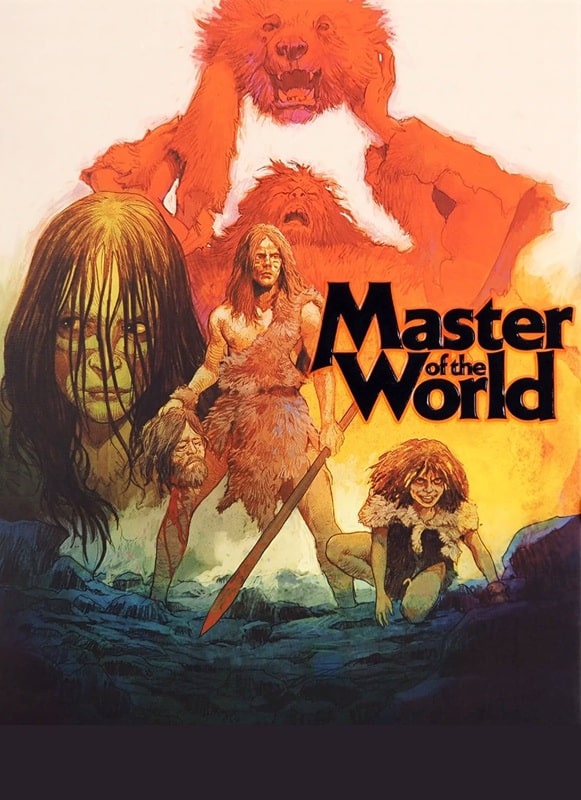 Master of the World (Falco Film, 1983)
Master of the World (Falco Film, 1983)
As usual, 20 films, all free to stream, and I’ve never seen them before. Can I really find 20 cave person films I can sit through?
EDIT: No. I’ve expanded the list to include any and all primitive cultures as there are not enough prehistoric flicks to watch.
EDIT: I’m capping this list at 10 – I can’t stomach any more f**king Italian cannibal flicks.
Master of the World (1983) TubiAgainst my better judgement, I’m starting a new list. The usual rules apply — 20 films, free to stream, based on a theme. This time, cave folk!
We kick off with this Italian offering from the early 80’s, obviously inspired by Quest for Fire and, um, possibly Caveman. It’s the old story of forbidden love, rival clans beating each other up and eating the brains of the vanquished, plus the invention of the bolas. It’s the Romeo and Juliet adaptation you never knew you needed.
The whole shebang is peppered with grainy stock footage of out-of-place animals and clouds, and there’s a man in a bear suit intercut with a real, heavily drugged bear, who beats the crap out of everyone. Actually, this semi-fake bear was a highlight.
As any nerd worth their salt will tell you, Ben Burtt used the sounds of a bear to create Chewbacca’s guttural growls. I swear to God, the filmmakers just took soundbites of Chewbacca from Star Wars and dubbed their own bear with them. Check it out — validate me!
Ultimately, a rather tedious affair, too much high-pitched grunting. I’m only one film in, and already regretting this.
3/10
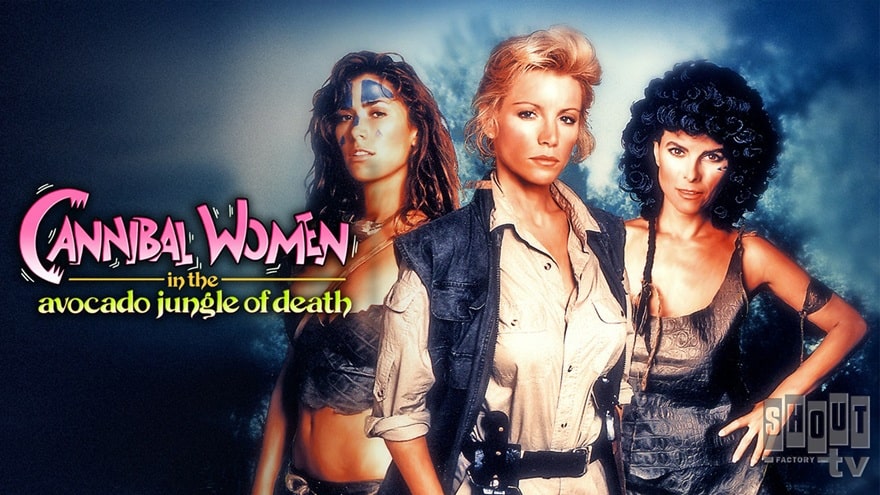 Cannibal Women in the Avocado Jungle of Death (Paramount Home Video, 1989)
Cannibal Women in the Avocado Jungle of Death (1989) Tubi
Cannibal Women in the Avocado Jungle of Death (Paramount Home Video, 1989)
Cannibal Women in the Avocado Jungle of Death (1989) Tubi
Confession: I could only find about a half dozen prehistoric cave people flicks (that I hadn’t seen or are free to stream), so I have expanded the parameters to include any ‘primitive’ cultures or groups. This opens up the doors for a wider selection, and a lot more rubbish. Case in point…
I thought I had seen this, but I was probably confusing it with Amazon Women on the Moon — anyhoo, this is a weird little affair, very cheaply made, and a bit of a mess. I’ve seen it described as a comedy horror, but there’s no horror in it, and very little in the way of good comedy. The script, written by director J.F. Lawton (who wrote Pretty Woman and Under Siege!) is really not as funny as he thinks it is, flip-flopping between absurdist schtick in the Airplane vein, to satirical monologues — all of which outstay their welcome very quickly.
Shannon Tweed is perfectly fine as the lead, but Adrienne Barbeau is wasted, and the least said about Bill Maher the better (although he does nail a couple of pratfalls). The film claims to be a commentary on feminism and toxic masculinity, but neither theme is realised due the reliance on tired tropes (the male gaze, the white male savior). Oh well.
4/10
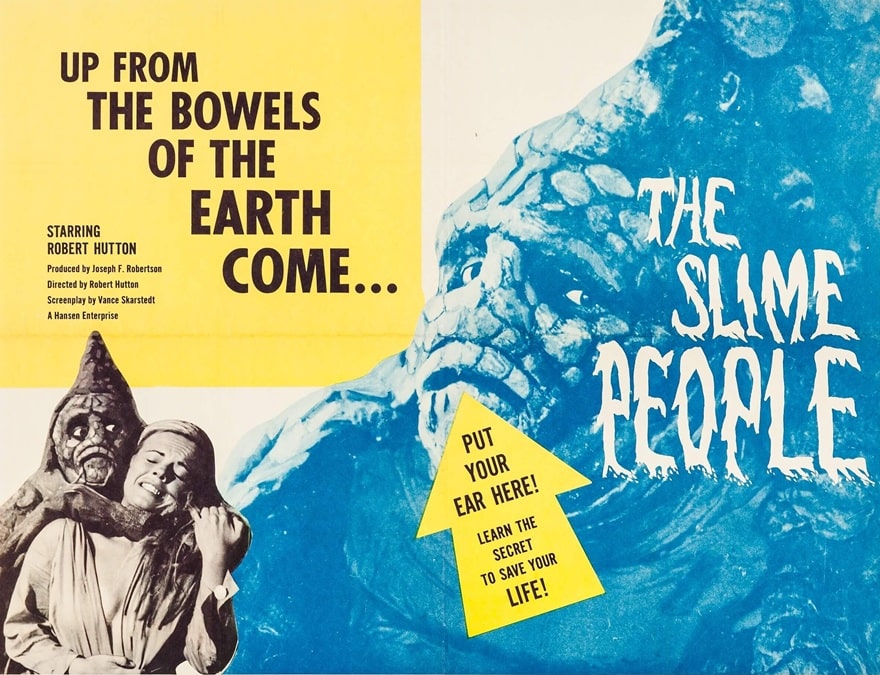 The Slime People (Donald J. Hansen Enterprises, 1963)
The Slime People (1963) Prime
The Slime People (Donald J. Hansen Enterprises, 1963)
The Slime People (1963) Prime
A primitive prehistoric race rises from the sewers to reclaim the planet after some misguided nuclear testing? Yes, this fits the criteria.
Is it any good though? Weeeellll…
It starts off pretty well. A lone pilot flies into a California airport, only to find the entire town deserted. It’s well set up, and would be even more effective if the film hadn’t shown us the titular monsters as soon as the film starts, before the credits. The monsters themselves are quite interesting, however it looks like they blew the budget on three full-size costumes; think Dr. Who‘s Zygons wearing gorilla pants.
The rest of the ensemble is made up of the usual suspects: lantern-jawed Clark Gable-lite, useless scientist, useless scientist’s useless daughters, useless marine (only there to say ‘gee whiz’ and kiss a useless daughter) and a nutcase who has ‘uncomfortable feelings’ for his goat. You read that right.
The whole affair is shrouded in fog (a major plot point) as mostly consists of lots of talking and running through the afore-mentioned fog. It’s a bit rubbish, but strangely compelling.
5/10
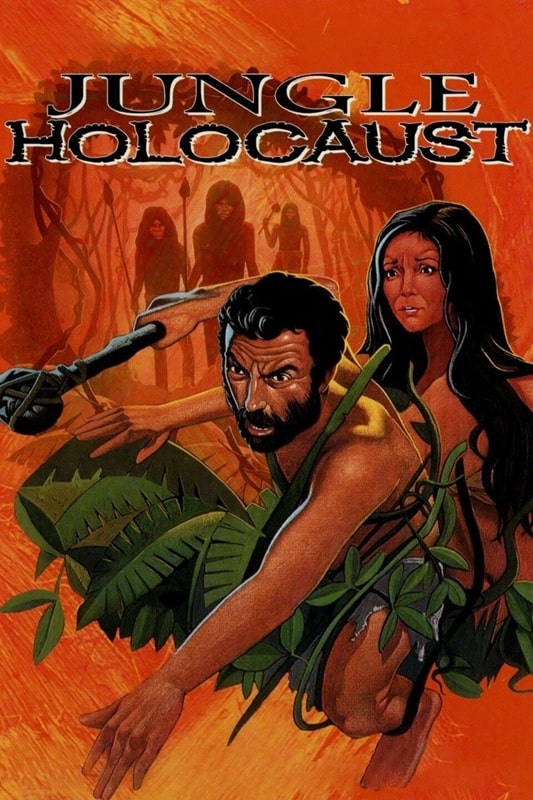 Jungle Holocaust (Erre Cinematografica, 1977)
Jungle Holocaust (1977) Tubi
Jungle Holocaust (Erre Cinematografica, 1977)
Jungle Holocaust (1977) Tubi
Of all the horror sub-genres, jungle cannibal ones are my least favourite. There’s simply no joy to be found in any of them, and combine them with the Italian predilection for animal cruelty, and you’ve got a film I never need to see twice. This one is the first foray into the genre by the much lauded Ruggero Deodato, and it’s not as ghastly as his later offerings, but still enough to leave me questioning my life choices. I can deal with the human-on-human buffets, but the suffering of real animals turns my stomach.
Anyhoo — it’s the usual plot; white Italians enter the jungle, get eaten. Along the way there is stock footage of animals eating each other, ants in wounds, copious willy tugging (some bad, some good) and lots of ‘oo, oo, oo’ ‘aah, aah, aah’.
The leads are pretty good, Massimo Foschi really sells the whole jungle madness look, and Me Me Lai is great as the loveliest cannibal of them all. However, at the end of the day I don’t mean to be judgemental, but I have no idea how anyone can watch these for a good time.
6/10
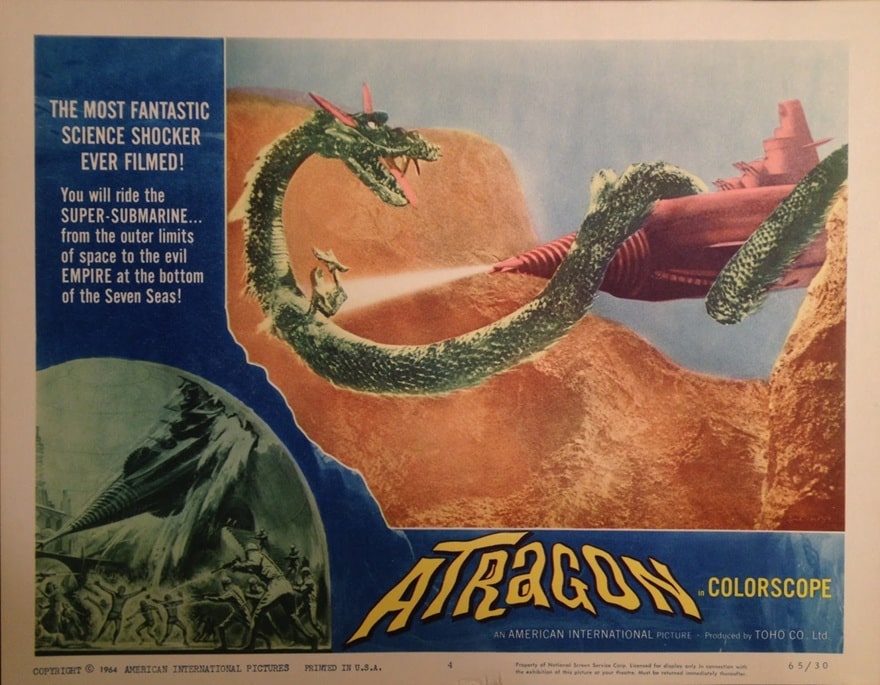 Atragon (Toho, December 22, 1963)
Atragon (1963) Prime
Atragon (Toho, December 22, 1963)
Atragon (1963) Prime
A tenuous fit for this project, Atragon features an ancient civilization (the Empire of Mu) hellbent on reclaiming their position as rulers of the world. For now, their continent lays at the bottom of the Pacific, so the film is all about Japan’s experimental submarine program, patriotism, and nefarious agents.
The entire world rallies via stock footage as the Mu Nemo themselves around the globe, sinking ships and being a general nuisance. Lots of lovely matte paintings and Thunderbirds-style models, and a bonus sea monster at the end. I had fun.
6/10
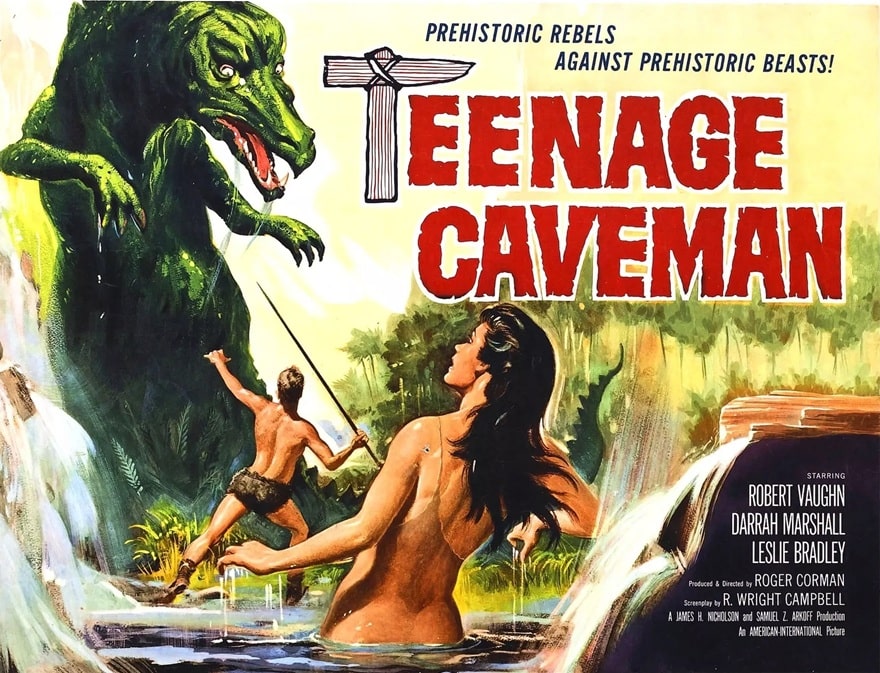 Teenage Caveman (American International Pictures, July 1, 1958)
Teenage Caveman (1958) Prime (AMC+)
Teenage Caveman (American International Pictures, July 1, 1958)
Teenage Caveman (1958) Prime (AMC+)
Yes, I started a free 30-day trial sub to AMC+ just so that I could watch this movie without the MST3K voice track. Such is my commitment to this pointless exercise in procrastination.
Anyhoo — here we have Roger Corman writing and banging out a caveman film in a couple of weeks. All shot on one California location, amply sprinkled with footage from other AIP flicks, featuring a very young Robert Vaughn as a young ‘cave person’ in the midst of an existential crisis. The clan he belongs to is the cleanest, whitest bunch of knuckle-draggers you’ve ever seen, and their hair is perfect. They all adhere to a bunch of rules attributed to Sky Gods and Monsters (TM), but Bobby Vaughn ain’t down with no rules, daddio.
He rebels, as all teens should, and while the elders sit around at camp discussing the rules, he goes out to see what’s so dangerous about the other side of the river. Here’s the thing, despite it being cheesy as hell, and somewhat laughable, Vaughn plays it straight (the right choice) and Corman clubs us around the head with a killer twist. I rather enjoyed it. Second film to feature a dude in a bear costume too, so it gains back the mark I was about to take away for the cruel real animal fighting.
6/10
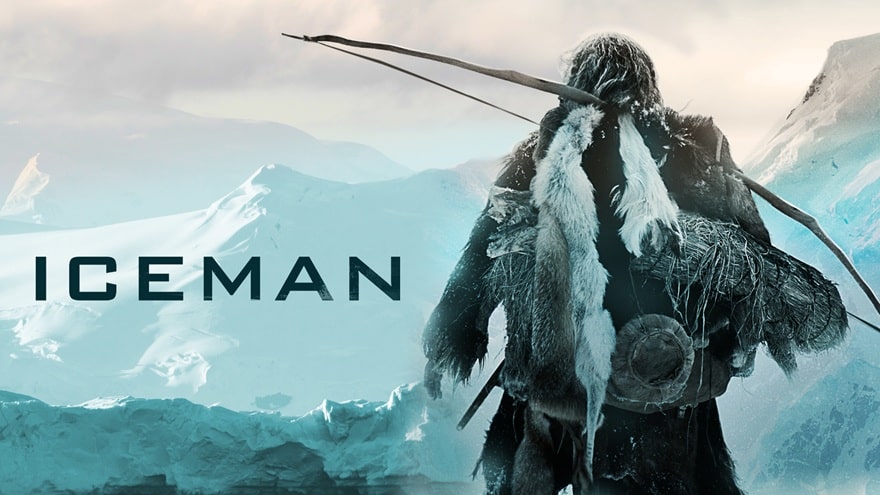 Iceman (Echo Film/Lucky Bird Pictures, 2017)
Iceman (2017) Tubi
Iceman (Echo Film/Lucky Bird Pictures, 2017)
Iceman (2017) Tubi
Based on a 5300-yr-old mummy found by hikers in 1991, this German production proceeds to tell the imagined last days of a Neanderthal man, Kaleb. It’s a simple revenge flick, told in the ancient Rhaetic language, and is beautifully shot through with a suitably grim palette.
Jürgen Vogel as Kaleb is brilliant, bringing physical and emotional heft to every scene, and it was a treat to see Franco Nero pop up. It’s solid, at times horrific, and a reminder that revenge is a dish best served hunted, skinned and roasted.
8/10
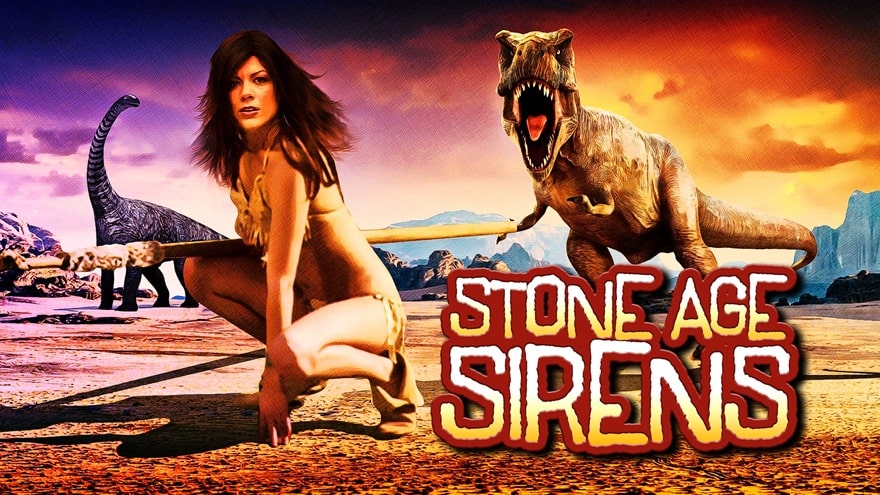 Stone Age Sirens (Retromedia Entertainment, November 16, 2004)
Stone Age Sirens (2004) Tubi
Stone Age Sirens (Retromedia Entertainment, November 16, 2004)
Stone Age Sirens (2004) Tubi
Another Fred Olen Ray flick (credited as Nicholas Medina, his soft-core pseudonym), this one is a heavily edited version of the film Teenage Cave Girl, heavily edited to the point where there’s no actual Neanderthal nookie on display at all. By cutting out all the sex scenes, what you are left with is a rubbish comedy about a pair of cave dwellers who are transported to the future and fall in with some randy archeologists (there’s more than you knew).
Peppered with stop-mo shots stolen from Planet of the Dinosaurs and some abominable CG in all its 8-bit glory, this is the usual slice of fried shite I’ve come to expect from the once great Ray. It gets a point for only being 46 minutes long.
1/10
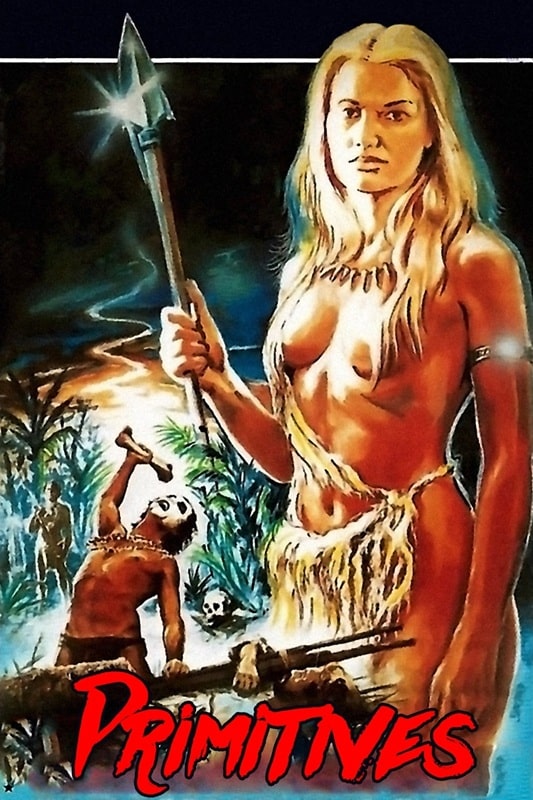
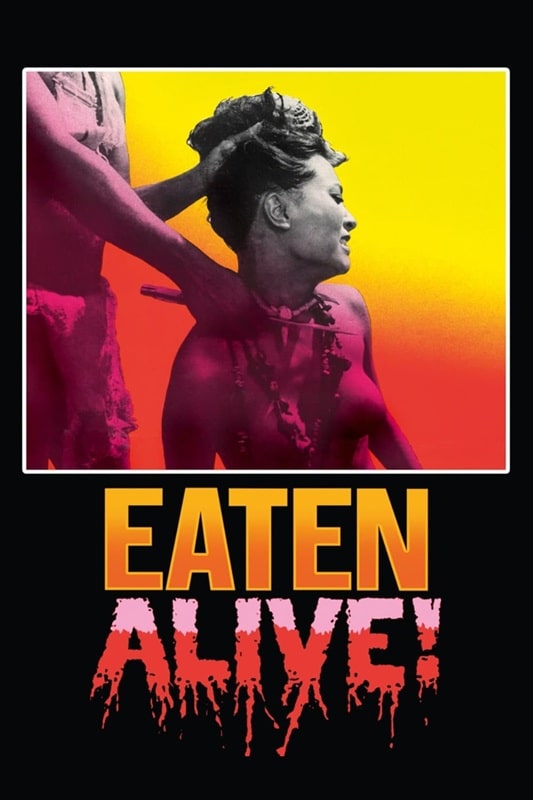
Primitives (Rapi Films, 1978) and Eaten Alive! (Dana Film, March 20, 1980)
This one is an Indonesian version of the Italian jungle exploitation flicks, and doesn’t just follow a similar plot, but lifts whole sequences directly for previous fare such as Cannibal Holocaust. In fact, it’s pretty shameless how much is ripped off from that movie, right down to locations and set pieces (although it stops short of actual tallywhacker removal). It’s full of the usual grunting and chomping, and the filmmakers seemed to double-down on the animal cruelty, using horrific footage from previous films.
It’s a miserable viewing experience, and I’m only giving it an extra mark for the shameless stealing of inappropriate music (Kraftwerk’s ‘The Robots, a trio of Jean Michel Jarre tracks and Princess Leia’s theme) and a hilarious rubber axe boomerang scene.
4/10
Eaten Alive! (1980) TubiNot to be confused with the Tobe Hooper ‘gator romp, this is another Italian cannibal flick that starts interestingly in New York, but then descends into the usual animal torture and misogyny associated with these films.
It’s held together by a flimsy ‘Jonestown’ plot, but this was the one that officially finished me off — I am totally done with this genre and never need to see another jungle cannibal film ever again. Hateful.
1/10
Previous Murkey Movie surveys from Neil Baker include:
There, Wolves
What a Croc
Prehistrionics
Jumping the Shark
Alien Overlords
Biggus Footus
I Like Big Bugs and I Cannot Lie
The Weird, Weird West
Warrior Women Watch-a-thon
Neil Baker’s last article for us was There, Wolves: Part III. Neil spends his days watching dodgy movies, most of them terrible, in the hope that you might be inspired to watch them too. He is often asked why he doesn’t watch ‘proper’ films, and he honestly doesn’t have a good answer. He is an author, illustrator, outdoor educator and owner of April Moon Books (AprilMoonBooks.com).
6 Books Begging To Be Held & The Advantages of Reading Them
In a society ruled by digital displays, it’s simple to overlook the pure pleasure and…
The post 6 Books Begging To Be Held & The Advantages of Reading Them appeared first on LitStack.
ROSE / HOUSE by Arkady Martine
Comment on A Beginner’s Guide to Drucraft #32: Sigl Recycling (II) by Jim Sackman
I am guessing that if Stephen could get hooked up with the right people, he could make a bunch of crappy sigils for the entire purpose of selling them to be recycled.
New translation rights acquired
Czech rights to Robert McCammon’s Swan Song and Boy’s Life have been acquired by Czech Republic publisher OneHotBooks.
Ukrainian publisher Zhorzh has acquired the Uktrainian rights to Robert McCammon’s Mister Slaughter, The Providence Rider, and The Listener. Zhorzh previously acquired the rights to Boy’s Life, Swan Song, Speaks the Nightbird, and The Queen of Bedlam. Their translation of Boy’s Life will be released in May.
Zhorzh on Facebook – https://www.facebook.com/ZhorzhClub
Zhorzh on Instagram – https://www.instagram.com/zhorzhclub/
Wednesday, Thursday, Hughday… Chapter 5: Part 1

Elara bent over the map, spread over the table. The herb patch… The berry bushes… The maples on the north side…
A presence tugged on her. She raised her head. Hugh stood in the doorway.
Alive. Uninjured.
She let out a mental breath and straightened. “You’re back.”
“I am.” His voice held no bravado. He sounded, not subdued exactly, but quietly resigned. She braced herself.
“Casualties?” she asked.
“None on our side. Something smells amazing.”
“I made chicken for dinner.”
He smiled but it didn’t reach his eyes. “Is it for me?”
“Yes. You did come back safely.”
“Can it wait?” he asked. “I need your help.”
“Of course.” What was going on with him?
He invited her out with a sweep of his hand. She left the room, and they went down the hallway side by side. The Keep was quiet. Soft afternoon light spilled through the windows, drawing long rectangles on the hallway floor.
“What happened in Aberdine?” she asked.
“Falcon blocked our approach. We had some words and then Bale decorated the road with Falcon’s brains. The rest of the mercs cleared off.”
He still sounded off.
“Is this going to come back to bite us?” she asked.
“Possibly. The second half of the company is enroute to Aberdine. The woman who is leading it could prove difficult. It depends on whether she decides to make an issue out of Falcon’s death or if she assumes command and takes what’s left of them somewhere else. If I were her, I’d count my blessings, but some people lack common sense.”
They reached the staircase and started down the steps.
“And if she decides to attack?”
“I’ll crush her.”
There was no force in his voice. He said it so matter of fact, as if he were talking about taking out the trash.
“Hugh?”
“Yes?”
“What’s wrong?”
He looked straight ahead.
“About ten years ago we came across a corpse town in the Laurentian Uplands in Ontario. Men, women, kids, all dead, rotting in the street.”
His tone was flat and weary.
“We found one survivor. A skinny kid about fifteen or so. Someone nailed him to a tree.”
Nailed?
“He should’ve died but he was too stubborn to let go. We took him with us.”
“What happened to town?”
“He never told us. He barely talked. Once we fed him enough for his legs to support his weight, I asked him what he wanted to do. He said he wanted to get stronger.”
Hugh sighed. “Some people are born swordsmen. It’s not something you can teach or train. The kid picked up the sword, and he was gone. He’d wake up in the morning and train until he passed out in the evening with a sword in his bed. Bale’s berserkers had adopted him. They all used to watch out for him, because he forgot to eat. He wasn’t the strongest or the most skilled, but he was fast, and he had the killer instinct. When he faced an opponent, the world disappeared. Nothing else existed.”
He fell silent.
“Was he as good as you?” she prompted.
“Almost. With magic down, he’d be a problem for me. Possibly even for Daniels.”
He brought up Kate. That usually meant he’d gone into a dark place. Roland’s biological daughter was the reason for his exile. They had a long and tangled history, none of it good. Hugh had done horrible things while under Roland’s control and they plagued his soul festering there until they ruptured into open sores. Kate was a wound that never healed.
“How long was he with you?” she asked.
“Eight years,” Hugh said. “We had a winter base near Wichita Falls in north Texas. Pretty country down there. Mild winter, lakes, rivers. We’d come back to it year after year when not on mission. One day he came to me and said he wanted out. He met a girl and decided he was done being a Dog.”
“But he loved being a swordsman?”
Hugh shook his head. “It wasn’t love. More like compulsion. It consumed him, and when he was with her, he could put it away. She freed him of it.”
“What did you do?”
“What could I do? I let him go. It was his second chance at life. He could be whatever he wanted to be. Everyone was happy for him.”
A cold unease washed over her. “Did you find him in Aberdine?”
“I did. I found him in that shithole of a camp. With people who didn’t deserve him and treated him like an attack dog. Those assholes couldn’t even be bothered with basic shit like guards and patrols. Elara, we just rode right in there. It was dirty and disorganized, a fucking disgrace. And those shitheads thought they could hold a town for ransom, and we would just let them.”
He was disgusted by all of it. The mercenaries had no idea how lucky they were. He could have just wiped them all out, and his face told her he had considered it. They probably deserved it.
“How the fuck did he end up there?” Hugh stopped. “He left with enough money to last him for five years. It should have been enough to take her anywhere and do whatever they wanted. Should I have kept him?”
“He wasn’t yours to keep,” she said gently. “You saved him, you trained him, and then you let him go. The rest was up to him.”
He gave her a dark look. “And he fucked it up.”
On the scales of Hugh’s life, with so much guilt and darkness piled up on one side, this young swordsman must have been a counterweight. Someone Hugh saved. Proof that he wasn’t irredeemable, that the Iron Dogs stood for more than slaughter and destruction. Even while under Roland’s influence, with his life going up in flames, Hugh had let him go. He was a remarkable asset, but his future happiness mattered, and Hugh released him.
Now that happiness lay in ruins. Seeing that broke something in Hugh. She could feel him retreating deeper inside himself, in the place where Hugh faded, and Roland’s warlord took the front line. The memory of a burning maelstrom with fangs she once saw in his soul scalded her. She had to keep him with her, anchored in here and now no matter what it took.
“If you’d kept him against his will, he could have died,” she told him. “You said yourself that Roland wrecked everything you built. As good as he was, he would be near the top of the execution list. At least he’s alive.”
“There’s that.”
“What happened to the girl?”
“I’ll show you.”
They’d reached the third floor. A trace of magic tugged on her. It came from the left, from the direction of the guest suite where they put potentially troublesome visitors. It felt sharp, almost spiky, like a cocklebur bristling with hooked needles. It pulsed in a subdued rhythm, active but muted.
She sped up. They marched down the hallway to the door. Hugh knocked and pushed the door open, not bothering to wait for an invitation.
A young woman with long dark hair lay on the bed. The burr of magic wrapped around her, fused with her body, strangled her vitality, growing from it like a parasite. Her eyes were shut, her skin was pallid, and patches of fuzzy dark growth, rippling with black, red, and purple, marked her exposed arms and neck. It looked like someone had scooped a toxic bacterial colony from some giant petri dish, smeared it all over her, and it took root.
A man in his mid-twenties sat in the chair by bed. He looked up at their approach and his eyes were full of grief.
The magic burr pulsed with power.
“A curse.” The word fell from Elara’s lips. She had never seen one like that.
“Can it be undone?” Hugh asked her.
“I don’t know. But we will try.”
The post Wednesday, Thursday, Hughday… Chapter 5: Part 1 first appeared on ILONA ANDREWS.
Rules for Mega-Dungeon Adventuring: Dragonslayer by Greg Gillespie
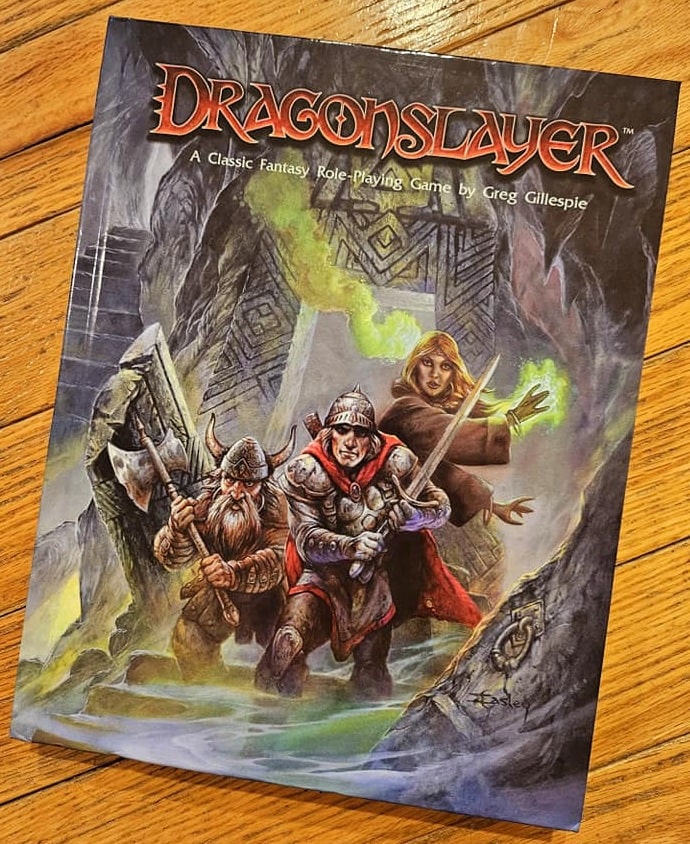
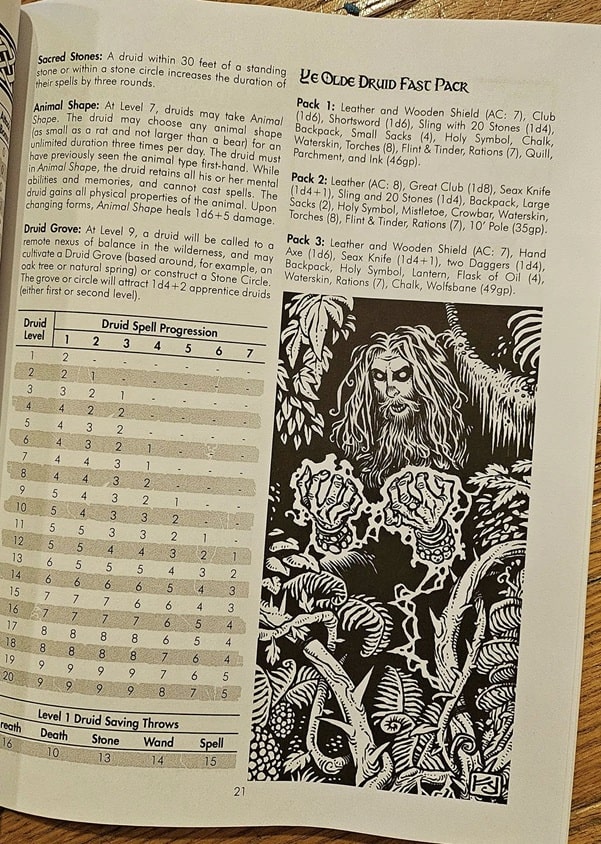
Dragonslayer (OSR Publishing, February 7, 2024). Cover by Jeff Easley
I’ve admired the mega-dungeon adventures of Greg Gillespie for several years, particularly Barrowmaze and The Forbidden Caverns of Archaia. Most recently, Greg published his own set of rules to go with those adventures. It’s called Dragonslayer, and I think it’s excellent. Here is the description from the back of the book:
Journey to a realm of myth and magic, where ancient legends and terrifying minsters come to life, and adventure awaits…
Inspired by the timeless role-playing tradition of the early 1980s, this ruleset seamlessly integrates the simplicity of B/X with the chrome if First Edition. The book has everything you need: classes, spells, monsters, and treasure, combined in a single volume.
For those who don’t know, “B/X” is the acronym for the Basic and Expert rules of Dungeons & Dragons.
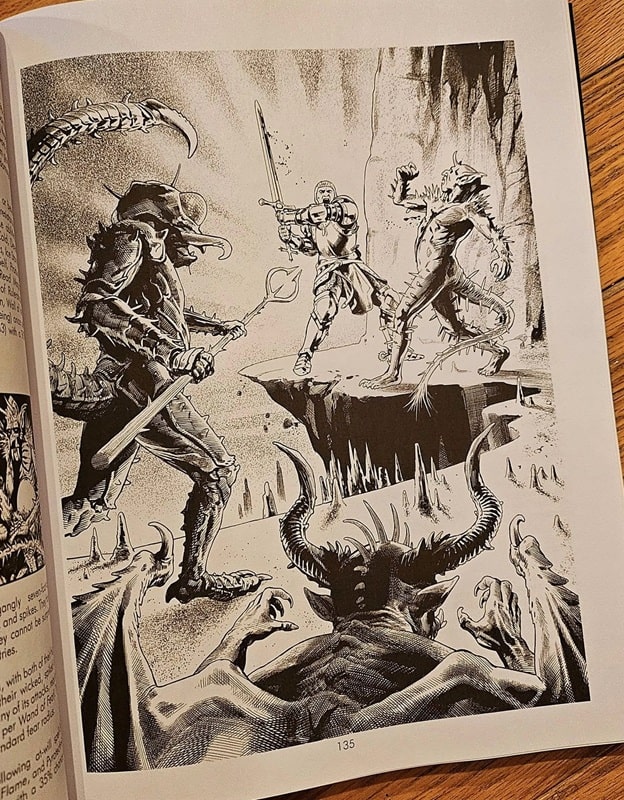
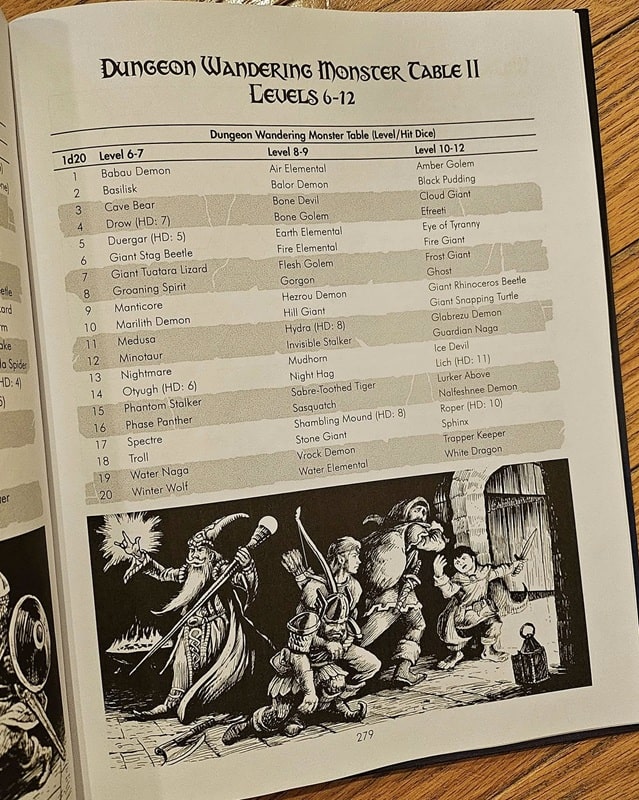
Interiors from Dragonslayer
The Basic and Expert rules were conceived by Tom Moldvay and Zeb Cook, who in turn derived their inspiration from the works of Gary Gygax and Dave Arneson — and also the previous Basic set (my personal favorite) compiled by John E. Holmes.
B/X is probably the most “cloned” version of D&D, yet Greg establishes his own flavor, quite admirably, within that framework. It’s nicely done!
Lastly, it’s really great to see art from the likes of Jeff Easley, Diesel LaForce, and Darlene Artist. All legends of the hobby whose work I have admired for decades.
Jeffrey P. Talanian’s last article for Black Gate was a review of Robert E. Howard’s “Worms of the Earth.” He is the creator and publisher of the Hyperborea sword-and-sorcery and weird science-fantasy RPG from North Wind Adventures. He was the co-author, with E. Gary Gygax, of the Castle Zagyg releases, including several Yggsburgh city supplements, Castle Zagyg: The East Mark Gazetteer, and Castle Zagyg: The Upper Works. Read Gabe Gybing’s interview with Jeffrey here, and follow his latest projects on Facebook and at www.hyperborea.tv.
PRE-ORDER NOW – Sufficiently Analysed Magic
The last thing the hyper-advanced Human Confederation expected to encounter on Darius – a far distant and long lost colony world – was actual magic, sorcerers and magicians and other inexplicable feats that the most advanced technology could not duplicate. Determined to discover the source of the mystery, the Confederation dispatched a survey team to Darius and eventually discovered that the human settlers had tapped into the Darius Machine, an inexplicable piece of alien technology that granted supernatural powers to those capable of calling upon its aid. The Darius Machine was accidentally destroyed, seemingly rendering the former godlike humans powerless, but leaving behind a number of children with strange and often frightening powers of their own.
That was seventeen years ago.
Since then, the Darius Children have been raised on Clarke, an isolated world where they can be studied as well as protected from the remainder of the human race. Their powers appear simplistic and yet very dangerous, provoking fear as well as awe in their teachers; their attempts to expand their abilities, and bring others into their mental network, threaten the very fabric of reality itself. As they start to demand the right to leave their homeworld, a sociopath strikes and kidnaps one of the Children, intending to sell her to the highest bidder. Another Child must go in pursuit …
And hidden in the shadows, an unseen manipulator lays the seeds of a galaxy-wide conflagration.
Purchase from the links HERE or BOOKS2READ!

What Moves the Dead - Book Review (reread/repost)

What Moves the Dead (Sworn Soldier #1)by T. Kingfisher
What is it about:From the award-winning author of The Twisted Ones comes a gripping and atmospheric retelling of Edgar Allan Poe's classic "The Fall of the House of Usher."
When Alex Easton, a retired soldier, receives word that their childhood friend Madeline Usher is dying, they race to the ancestral home of the Ushers in the remote countryside of Ruritania.
What they find there is a nightmare of fungal growths and possessed wildlife, surrounding a dark, pulsing lake. Madeline sleepwalks and speaks in strange voices at night, and her brother Roderick is consumed with a mysterious malady of the nerves.
Aided by a redoubtable British mycologist and a baffled American doctor, Alex must unravel the secret of the House of Usher before it consumes them all.
What did I think of it:I totally pre-ordered this book because it sounded cool and I couldn't resist that cover! (The end-papers have a really cool illustration as well.)
And this is indeed a really cool read!
It's a retelling of Edgar Allan Poe's "The Fall of the House of Usher." , but you can definitely read it without having read Poe's original. It's atmospheric, disturbing, and delightfully creepy.
I loved Alex, they're a great hero: down to earth, pragmatic, but also caring towards their friends. And their narration brings some humor to an otherwise creepy tale. Having read a lot of Poe's works, the plot wasn't unfamiliar, but the way Kingfisher gave it life and brought new things to it made that I was invested from the start.
A warning to those who might have read other books by Kingfisher (A Wizard’s Guide to Defensive Baking or Paladin's Grace for example): Kingfisher is a pen name used by Ursula Vernon for anything that doesn't fit the Ursula Vernon name, so this book is very different than some of the other books written under the Kingfisher name.
You bet i'll be trying to find more creepy, atmospheric beauty among the Kingfisher books though!
Why should you read it:It's a delightfully atmospheric read.
Thoughts on rereading:Yup: Still just as beautifully atmospheric as the first time. A total keeper. Now on to read the next one.
Comment on A Beginner’s Guide to Drucraft #32: Sigl Recycling (II) by Bill
Thanks again for the weekly Drucraft update. As always very useful and thought provoking. I’m wondering if Stephen would need a room to construct his own well or if it is just a piece of private open space, as I don’t think that essentia is constrained by walls and such? On the other hand he knows, at this stage, where a lot of natural, hidden wells can be found so he may be happy to use those locations.
Hum, perhaps he isn’t thinking at all about this anyway as he (currently) doesn’t have a lot of high power sygls to convert!
I hope that work on Book#4 is progressing well and that the sales of Books#1 & #2 continue to live up to expectations. Sadly, for me, A Judgement of Powers still seems a long way from publication. Six months to go!
Book review: Castaways (The Castaways #1) by Craig Schaefer

Book links: Amazon, Goodreads
ABOUT THE AUTHOR:
Publisher: Length: Formats:
Dark academia by Craig Schaefer? Yes, please. Especially the kind that leans hard into the dark. Castaways delivers good story, some eldritch horror vibe, and strong coming-of-age arcs.
Amy Nettle is a classic down-on-her-luck protagonist. She’s stuck in a dead-end life with limited way out. And when things go really south, the mysterious black envelope arrives. Suddenly, she’s whisked away to Saunders Academy, a magical school on a storm-tossed island surrounded by carnivorous mermaids, towering leviathans, and an ever-present sense that something is very wrong.
And if you flunk out? You get sent back to your old life without your magic, your memories, or even the promise of escape. And no one here wants to go back.
I’m a huge fan of Schaefer simple and concise writing. And characters. Amy and her new friends are coming of age in the middle of a mystery that keeps getting bigger and more terrifying. There are hints that this school - and whatever forces control it - are tied to the broader Daniel Faust/Harmony Black universe, and that may suggest an even larger conflict on the horizon.
For fans of Schaefer - it’s not as dark as other series, but it does get dark here and there.
Magic school has never felt this dangerous, and I loved every second of it. Now, where’s the sequel?
We No Longer Need Aliens to Feel Alienated: State of Paradise by Laura Van Den Berg
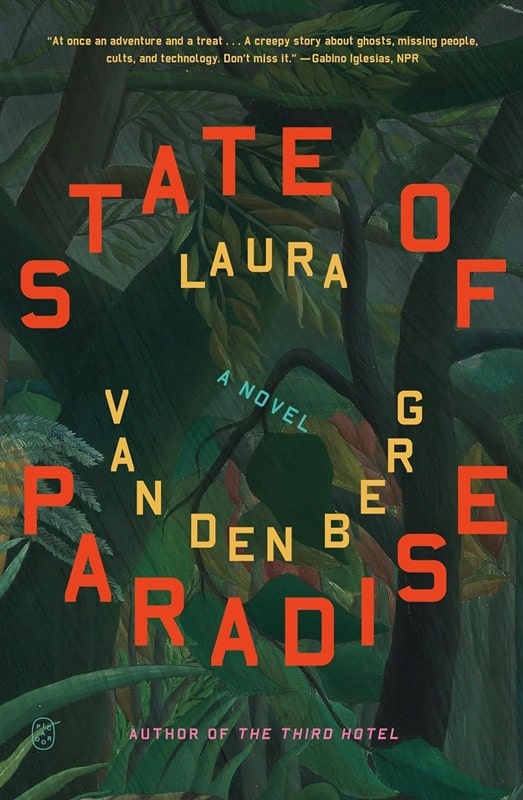
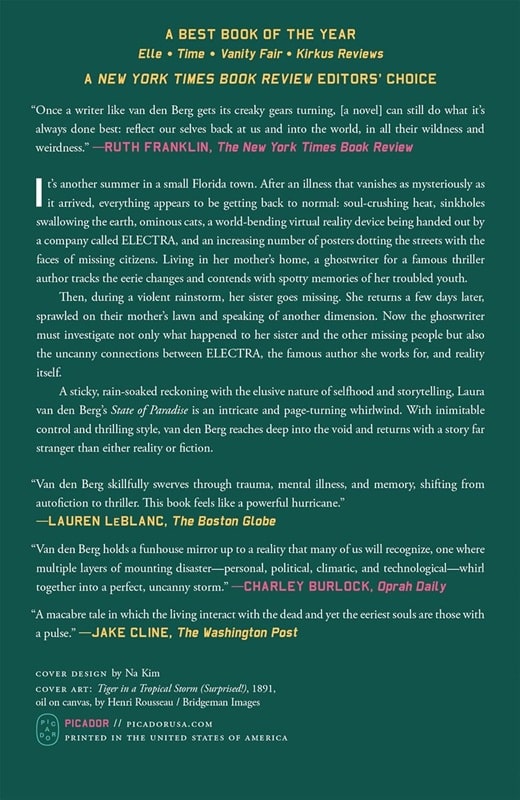
State of Paradise (Picador paperback reprint, July 8, 2025). Cover art:
detail from Tiger in a Tropical Storm by Henri Rousseau, 1891
When I was a kid there was a public service announcement on TV that went something like “Attention: Aliens. You are required by law to report by January 31st.” This was because of the Alien Act of 1940, otherwise known as the Smith Act. Basically, the legislation made it illegal to advocate the violent overthrow of the U.S. government and provided for a tracking system of non-citizens who, in the context of Nazi occupation of Eastern Europe and its then alliance with the Soviet Union, were potential suspects of espionage and sabotage. (Fun fact: prosecutions for advocating overthrow of the government have been ruled as unconstitutional violations of the First Amendment, in case you were wondering how any nitwit on social media can mouth off about doing just that.)
But as I didn’t know anything about this, the announcement always conjured an image of big headed, bug-eyed tentacled Martians registering at the local post office. Which I thought pretty funny. One thing I’ve learned over the years, and particularly these days, is that much of what adults say in all seriousness is often funny, but not in a “ha ha” way. More in a Jean Paul Sartre absurdist kind of way.
Needless to say, alien life forms are foundational science fiction, horror, and fantasy tropes. While some genre writers and filmmakers may very well have thought it just might be cool to tell stories about monsters from other worlds, the notion of aliens amongst us primarily serve as metaphors for, among other things, Communists and related usurpers of “normal” socio-political mores, fears of nuclear holocaust, technology run amok, repressed sexual desire, climate change, disease, and disembodiment.
Probably to a large extent due to the COVID-19 pandemic as well as severe climate events such as the California wildfires, today’s alienation storyline is less “aliens amongst us” and more “us alienated from the world.”
Which brings us to State of Paradise by Laura Van Den Berg.
The title is ironic, referring not only to Florida and its reputation as a refuge for the aged retired, the sunburned, and the weird, but that if the existential human condition is sometimes characterized using the Biblical metaphor of banishment from Eden, we currently find ourselves further away from Paradise than ever before.
In Florida, my husband runs. Ten miles a day seventy miles a week. a physical feat that is astonishing to me. He started running after he got stuck on a book he is trying to write, a historical account of pilgrims in medieval Europe. Back then it was not unusual for pilgrims to traverse hundreds of miles on foot… My husband is a trained historian and fascinated by journeys. He wants to understand what has become the pilgrimages in our broken modern world.
The first person narrator is
…a writer, though not a real one, I ghost for a very famous thriller writer. When I first got the job, I spent a month reading books by the famous author, to better understand the task that lay before me… the phrase everything is not as it seems appeared in nearly all the book descriptions.
Indeed, everything is not as it seems as the narrator (a kind of ghost herself) proceeds on a pilgrimage not only through actually weird Florida, where the 1930s Tarzan movies were filmed and non-native Pythons abound alongside Everglades alligators and Disney characters, but an alternate reality to which her sister and others somehow travel. Along the way are treated to torrential rain and flooding, sinkholes, virtual reality headsets, cults, and cats. And voluntary human extinction meetings. Just another day in Paradise.
With a history of being institutionalized, our narrator may be unreliable, and as a writer she is in the business of making things up. Not much cause for cognitive dissonance given the made-up unreliable narratives of our daily news cycle.
The plot, such that it is, concerns finding out what happened to her sister and others during their disappearances. And along the way what is happening to the narrator as she tries to figure out an increasingly strange world that nonetheless comes to define everyday existence. And whether she can trust what she is experiencing and what she remembers of those experiences.
Sometimes I wonder what we are supposed to do with our memories. Sometimes i wonder what our memories are for. A latch slips and the past floods in, knocking us flat. We leave places and we don’t leave places. Sometimes I imagine different versions of myself in all the different places I have ever lived, inching time in parallel.
This is a novel about the proverbial frog in boiling water, how because as the temperature only gradually rises, we don’t realize we’re being cooked. One absurdity follows another, and it is just how things are. We are now the aliens, journeying towards some unsettling destination, and we don’t have to bother to report.
One of the weirdest things about this period of time is the parts that still seem normal. Mundane and non-apocalyptical. Like how one minute we need an inflatable raft to cross the street and another we’re eating pasta at my sister’s house.
Or as Alice Cooper put it, “Welcome to my nightmare.”
David Soyka is one of the founding bloggers at Black Gate. He’s written over 200 articles for us since 2008. His most recent was a review of Polostan by Neal Stephenson.
Magic Binds Samples from Graphic Audio
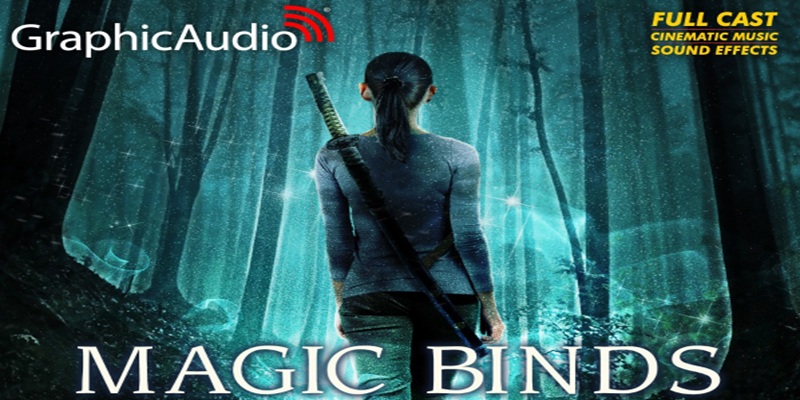
The Magic Binds full cast dramatized adaptation will be released on Tuesday, March 25th. The preorder is available on the Graphic Audio website, as well as on Audible and all the other usual third party retailers.
Of course, we got sample goodies!
What do you mean, ‘do I need cake right now‘? Kate. Beloved. We ALL need cake right now.
The three Queens guarding the line of Shinar – this Mishmar scene always gives me Canada goose bumps.
There is a third official sample on the preorder page I linked above: Kate and Curran visiting Roman about their wedding. Wedding planner shenanigans: engaged!
The next GA Ilona Andrews releases are:
Burn for Me, Hidden Legacy 1 on April 25th. You can also find find it for preorder on Audible etc.
Magic Triumphs, Kate Daniels 10 on May 20th – there is an update to the date here, it was previously set to come out on May 2nd, but the script is just too epic and Nora never lets a project be just good when she can make it amazing. A spoonful of sugar, intense editing, sound design and lots of loving work makes the final battles and psychotic ancient dragons go down! Ehhh, you know what I mean. Neig wishes. Preorder should go live on third party retailers sometime next week.
I’ve seen some concerned comments wondering how much content will be abridged from Magic Triumphs and Burn for Me because the length of the traditional audiobooks and the length of the dramatized adaptation always appear to have several hours of difference.
Having pored over both scripts, I’m happy to confirm the answer is: virtually nothing was cut! Those were in fact Nora’s first words to me when we started discussing Magic Triumphs, and who can blame her? Certainly not us hehe.
The differences in duration come mainly from the fact that animated dialogue has a different rhythm than a single narrator reading. Dramatized battle scenes, for example, rely a lot more on dynamic back and forth and the majority of GA actors are really embodying the snappy deadpan Ilona and Gordon wrote for their characters. Renee Raudman has her own signature cadence, which is the favourite of so many, but I know a lot of readers prefer to increase the speed of traditional audio.
Audio effects and interpretation can also supplant certain descriptive passages and action tags, with no difference to content. We can hear that the actor is laughing while delivering the line, or that the birds are singing while a conversation is taking place, the narrator doesn’t have to specify it to us.
You can read more about the adaptation process in previous interviews with members of the Graphic Audio team here and here.
I have covered in more detail how to buy and the accessibility of the GA app in this post, which you can also supplement with the Graphic Audio Help FAQ on their website.
The post Magic Binds Samples from Graphic Audio first appeared on ILONA ANDREWS.
Spotlight on “The Mysterious Bakery on Rue de Paris” by Evie Woods
Nestled among the cobblestone streets of Compiègne, there existed a bakery unlike any other. The…
The post Spotlight on “The Mysterious Bakery on Rue de Paris” by Evie Woods appeared first on LitStack.
On McPig's Radar - They Bloom at Night
 They Bloom at Nightby Trang Thanh Tran
They Bloom at Nightby Trang Thanh TranA red algae bloom has taken over Mercy, Louisiana. Ever since a devastating hurricane, mutated wildlife lurks in the water that rises by the day. But Mercy has always been a place where monsters walk in plain sight. Especially at its heart: The Cove, where Noon’s life was upended long before the storm at a party her older boyfriend insisted on.
Now, Noon is stuck navigating the submerged town with her mom, who believes their dead family has reincarnated as sea creatures. Alone with the pain of what happened that night at the cove, Noon buries the truth: she is not the right shape.
When Mercy’s predatory leader demands Noon and her mom capture the creature drowning residents, she reluctantly finds an ally in his deadly hunter of a daughter and friends old and new. As the next storm approaches, Noon must confront the past and decide if it’s time to answer the monster itching at her skin.
Of Men, Monsters, and Little People
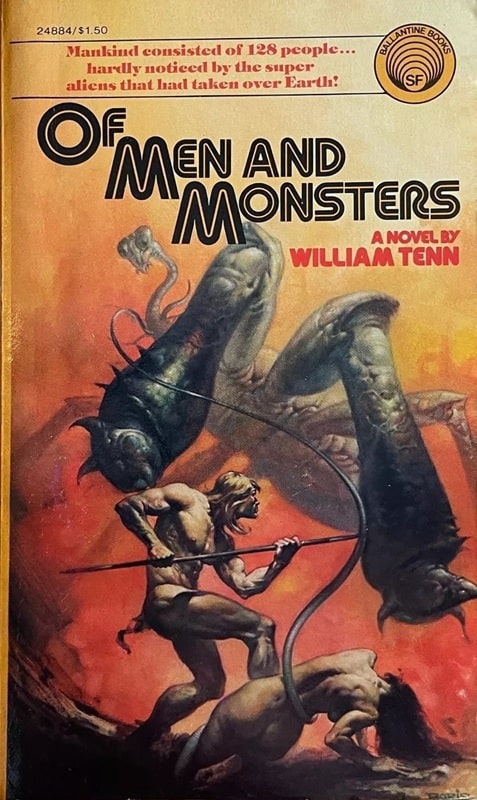
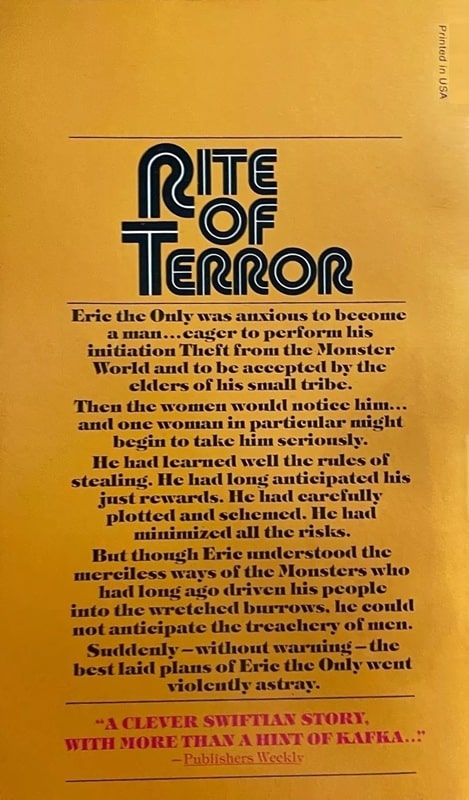
Of Men and Monsters, by William Tenn
(Ballantine Books, December 1975). Cover by Boris Vallejo
After posting about The Borrowers by British author Mary Norton (1903 -1992) last week, several people mentioned other books and movies with similar kinds of themes — little people living in the houses of big people. I thought I might take another post to discuss a few other examples from my own book collection.
First up is series by American author John Peterson (1924 – 2002). The first one was just called The Littles and was published in 1967, 15 years after The Borrowers (1952). The Littles live much like the “borrowers. They look human except for having tails. (In films they apparently look very mouselike but that’s not the case in the books.)
[Click the images for less little versions.]
 The Littles, by John Peterson (Scholastic Books, 1991-1993 editions). Covers by Jacqueline Rogers.
The Littles, by John Peterson (Scholastic Books, 1991-1993 editions). Covers by Jacqueline Rogers.
Unlike with The Borrowers, I never heard of The Littles until I was buying books for my own son, (Josh), even though many were written when I was a kid. I stopped by Josh’s school to pick him up one day and they were having the Scholastic Book fair.
When I was a kid, we never had a fair where you could actually see the books, but we did get the order forms and I bought quite a few books through them for 25 cents or so when in grade school. I had to stop by this one at my son’s school and found out about The Littles. I bought every one they had, ostensibly for my son but at least halfway for myself. I read them all, too, although I don’t think Josh read them all.
There are a bunch of these books and more were written after Peterson’s death, but here are the ones I have. All covers are by Jacqueline Rogers, with charming interior illustrations by Roberta Carter Clark. (These are written specifically for children and I don’t think the stories are as good as in The Borrowers series, but they are fun.)
The Littles, 1967
The Littles have a Wedding, 1971
The Littles and the Trash Tinies, 1977
The Littles Go Exploring, 1978
The Littles and the Lost Children, 1991
The Littles and the Terrible Tiny Kid, 1993
In my twenties I came upon another series about tiny people. This was a trilogy by Gordon Williams (1934 – 2017) that included The Micronauts (1977), The Microcolony (1979), and Revolt of the Micronauts (1981) — all from Bantam Books.
 The Micronauts by Gordon Williams (Bantam Books, August 1977, May 1979, and August 1981). Covers by Boris Vallejo, Lou Feck, and Peter Goodfellow
The Micronauts by Gordon Williams (Bantam Books, August 1977, May 1979, and August 1981). Covers by Boris Vallejo, Lou Feck, and Peter Goodfellow
These are SF novels, not to be confused with the toy series and comic book series from Marvel with the same name — which I’d never heard of until I started looking into stuff for this post. The difference here is normal sized people are cloned at 1/8th their natural size in order to deal with a catastrophic future where most natural resources have been exhausted. The experiment is set up in a controlled environment but things soon get out of control.
I liked all three very much and they had some cool covers. The Micronauts has a Boris Vallejo cover and interior illustrations. The Microcolony has a wonderful Lou Feck cover that I love. Revolt has a Peter Goodfellow cover.
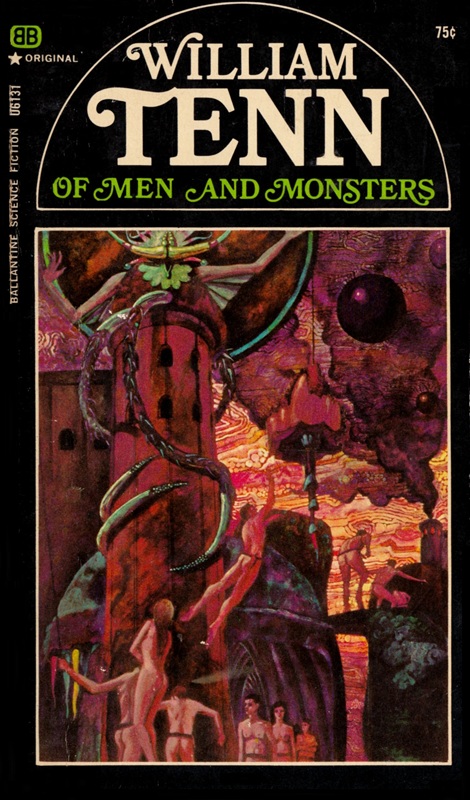
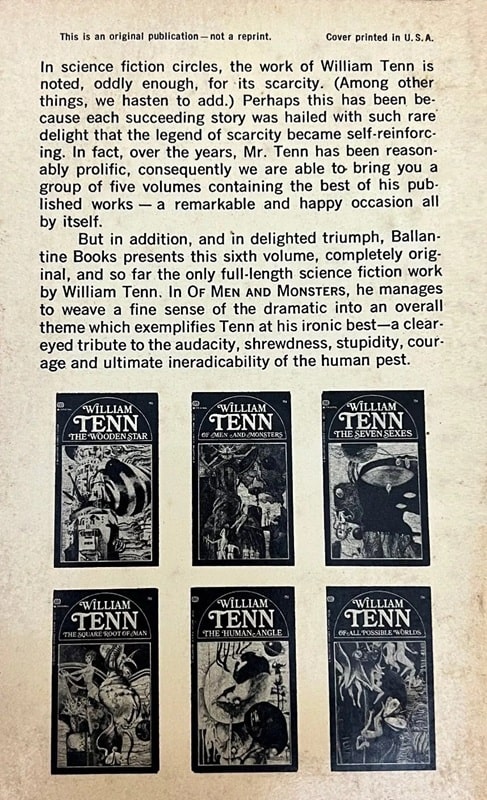
Of Men and Monsters, by William Tenn
(Ballantine Books, June 1968). Cover by Stephen Miller
The last book I’ll review today is one of the first adult SF novels I ever read, Of Men and Monsters, by William Tenn (1920 – 2010). It’s still a fond memory. Tenn was the pseudonym for a British born author named Phillip Klass, although he moved to the US before he was 2. The book was published in 1968 and I read it in a library edition, but years later I bought a Del Rey printing with a great cover by Boris Vallejo (see top).
This one has its own twist on the theme. The people are normal sized, but they are survivors of an invasion by gigantic aliens so huge that the humans can live like mice in their walls. I just loved it, and found out from Adam Tuchman on Facebook that it was originally published in a shorter version in the October 1963 issue of Galaxy, called “The Men in the Walls.”
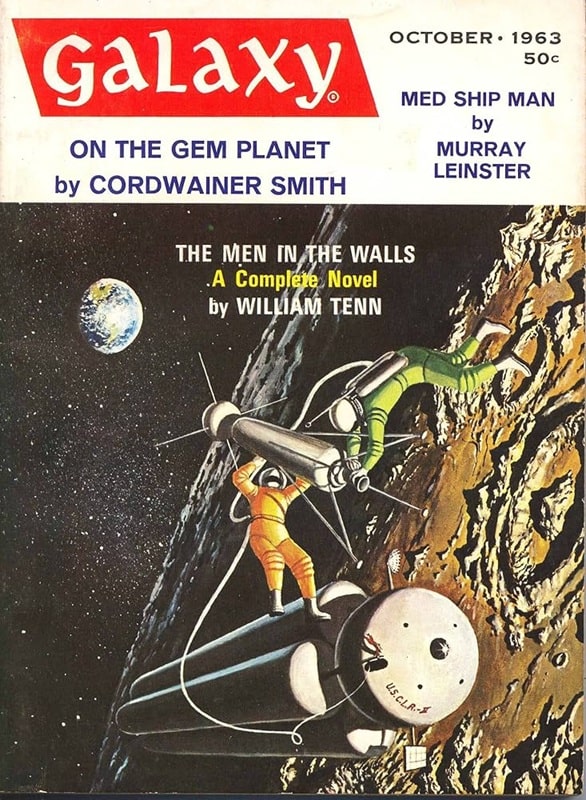
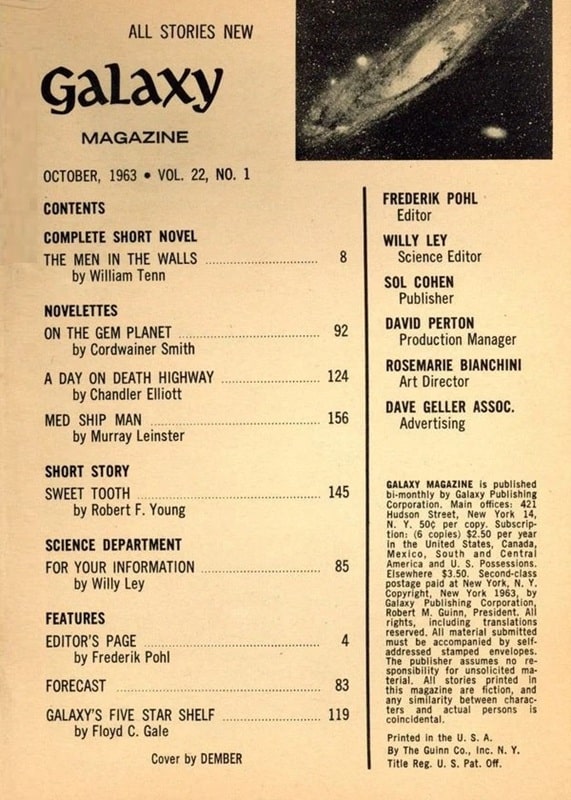
Galaxy, October 1963, containing “The Men in the Walls,” plus stories
by Cordwainer Smith, Murray Leinster, and more. Cover by McKenna
I’ll note that the ending Of Men and Monsters takes us into Sword & Planet territory.
There are plenty more I could talk about here, such as Lindsay Gutteridge’s Cold War in a Country Garden Trilogy, and Ben Sheppard reminded me of an awesome story called “Surface Tension” by James Blish, which deals with the miniaturization theme. There’s Asimov’s Fantastic Voyage, and even the movie Honey, I Shrunk the Kids, but this post is getting long as it is.
Charles Gramlich administers The Swords & Planet League group on Facebook, where this post first appeared. His last article for Black Gate was And Now For Something Completely Different: The Borrowers, by Mary Norton.
Cast by Flames audio pre-order
7 Author Shoutouts | Authors We Love To Recommend
Here are 7 Author Shoutouts for this week. Find your favorite author or discover an…
The post 7 Author Shoutouts | Authors We Love To Recommend appeared first on LitStack.
The Naturalist Society - Book Review
 The Naturalist Society (The Naturalist Society #1)by Carrie Vaughn
The Naturalist Society (The Naturalist Society #1)by Carrie VaughnWhat is it about:In this magical tale of self-discovery from New York Times bestselling author Carrie Vaughn, a young widow taps into the power that will change the world—if the man’s world she lives in doesn’t destroy her and her newfound friends first.
In the summer of 1880, the death of Beth Stanley’s husband puts her life’s work in jeopardy. The magic of Arcane Taxonomy dictates that every natural thing in the world, from weather to animals, can be labeled, and doing so grants the practitioner some of that subject’s unique power. But only men are permitted to train in this philosophy. Losing her husband means that Beth loses the name they put on her work—and any influence she might have wielded.
Brandon West and Anton Torrance are campaigning for their expedition to the South Pole, a mission that some believe could make a taxonomist all-powerful by tapping into the earth’s magnetic forces. Their late friend Harry Stanley’s knowledge and connections would have been instrumental, but when they attempt to take custody of his work, they find that it was never his at all.
Tied together by this secret and its implications, Beth, Bran, and Anton must find a way for Beth to use her talent for the good of the world, before she’s discovered by those who would lay claim to her rare potential—and her very freedom.
What did I think of it:I got this book as a present from Jeffe, and it's a signed copy as well!I have read books by Vaughn before - Kitty Norville, Martians Abroad - and I really enjoyed those. But I can't say Vaughn was on my watch list. I can tell you that this book changed that!
In this alternate history there's a sort of magic - taxonomy - where if you name something, and know it, you can use the magic/power of that thing or animal. I loved learning more of this magic and how the characters used it in different ways.
As for the characters: I loved Beth from the start. She's smart, knows more about birds than a lot of experts, and managed to teach herself taxonomy, but because she is a woman she is barred from the spaces where she could do something with her knowledge. She managed to get some of her work out there under her husband's name, who (all other stuff he did aside) at least encouraged her work. But when he dies, Beth is back at square one.
Enter Bran and Anton, who were friends with Beth's husband and want to use his work for their own goals.
I really loved Anton as well. He's pragmatic, charismatic, and keeps going to get things done. Bran... still needed to grow up a bit, despite being old enough he should have already. Still I liked him well enough.
I was totally invested in Beth freeing herself from the chains forged by society and find her way. When she befriends Bran and Anton, I rooted for the three of them to realize their dreams. Bran and Anton have a rival, who soon becomes a danger to Beth as well, making me anxious to see them get out of everything alive and successful.
I can safely say I loved everything about this book, even when it made me cry. I can't believe I hadn't seen it mentioned before and only discovered it when I got it as a present. Is it for everyone? I can see how people think it's too dry, there's lots of talk about the science of taxonomy, and there's bits about famous taxonomists at the end of most chapters, but I loved these parts of the book as well (yup: Nerdy Factoids McPig, and proud to be).
You bet I'll be on the lookout for the next book in this world.
Why should you read it:It's a wonderful Alternate History Read.
Book Review: The Buffalo Hunter Hunter by Stephen Graham Jones
I received a review copy from the publisher. This does not affect the contents of my review and all opinions are my own.
 The Buffalo Hunter Hunter by Stephen Graham Jones
The Buffalo Hunter Hunter by Stephen Graham Jones
Mogsy’s Rating: 4.5 of 5 stars
Genre: Horror
Series: Stand Alone
Publisher: Saga Press (March 18, 2025)
Length: 448 pages
Author Information: Website
At its heart, The Buffalo Hunter Hunter may be a vampire novel, but it’s about so much more that calling it such would be doing it a great disservice. Yes, the story involves undead, blood-drinking creatures. However, it is also a meditation on the scars of history, and, like any good western, features a tale of vengeance. In short, Stephen Graham Jones has created something far more complex than your typical vampire horror here.
The novel opens in 2012 with an introduction to Etsy Beaucarne, a junior professor at the University of Wyoming who is desperately looking for a way to revitalize her career. Her opportunity arrives when she comes into possession of a long-lost journal belonging to her great-great-grandfather, a Lutheran priest who lived in the American West in the early 1900s. Within its pages, Arthur Beaucarne had transcribed a stunning confession from a Blackfeet man named Good Stab who claimed to be an immortal vampire.
Through Good Stab’s recorded testimony, readers are plunged even farther back in time to the brutal winter of 1870, when US Army soldiers carried out the Marias Massacre that left hundreds of his people dead. Good Stab, one of the few survivors, swore that he would get his revenge, spending the next few decades hunting down those responsible. Yet his survival came at a heavy price. After losing his family, his home, and even his place in the world, Good Stab’s path changes his life forever. Possessed of both immense power and an insatiable hunger, he knows what happened to him is a curse—but it’s also one he can wield as a weapon against those who destroyed everything he once knew.
From the start, The Buffalo Hunter Hunter’s frame structure brings to mind Dracula, which is not the only nod to the classic. Stephen Graham Jones continues his homage with the epistolary style format, enhancing the story’s eerie, almost folktales-y like atmosphere. Despite its supernatural elements though, some of the most disturbing aspects of the novel are the parts rooted in reality—particularly the history of Indigenous genocide and the annihilation of the buffalo.
In Good Stab’s account, he wasn’t merely seeking revenge for the slaughter of his people, but also for the destruction of his whole way of life. His vampirism not only holds him forever in a state of constant hunger but also traps him in an endless cycle of rage and grief. Immortality offers him no peace but instead forces him to witness more loss as the years stretch on. This makes Good Stab one of the most interesting and tragic characters I’ve ever encountered. He isn’t a hero or a villain—just a man and then a creature driven by circumstance.
Like most vampire stories, The Buffalo Hunter Hunter is unsurprisingly violent and gory. That said, its horror manifests itself in lowkey, slow-burn ways as well. The author’s prose captures the harshness of the frontier, an unforgiving landscape where you are constantly struggling to survive. Though the pacing may be demanding at times, this story simply must be experienced on its own terms, requiring your full attention. With its mix of so many elements from history, mythology, and horror, this is not a book to be rushed but to be absorbed slowly, allowing its haunting themes to fully take hold.
If I had any criticisms at all, it would be that some parts of the story become repetitive at times, especially with regards to the interactions between Arthur and Good Stab. While this back and forth served to reinforce the narrative style, I think the novel could have packed the same emotion punch without being quite so long, and some streamlining would have been beneficial.
In the end, I absolutely loved The Buffalo Hunter Hunter, as in, it just might be my favorite book by the author yet. While it’s not the easiest read, the end results are satisfying and rewarding. Stephen Graham Jones’ storytelling skills are on full display here, and it would make me very happy to see him tackle more historical horror like this sin the future. Granted, I haven’t enjoyed everything he’s written, but when he’s good, he very good. And with this novel, he’s proven once again why he is one of the most important voices in the genre today. If you enjoy horror with depth, especially one exploring a dark chapter of American history, this is a must read.
![]()
![]()

Recent comments